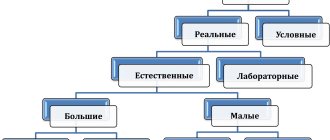As a rule, temperament is inherited by a child from one of the parents; also, in the process of upbringing, some character traits are adopted, which can be strengthened.
Articles on the topic
- Poor parenting and its impact on human behavior 08/24/2021
- What does a femme fatale mean and how does she differ from a bitch 06.24.2021
- Types of women in psychology 06/24/2021
- Hysterical personality type of a woman: features of communication 06.16.2021
Biography
Hippocrates
Hippocrates received his initial medical education from his father, the physician Heraclides. For the purpose of scientific improvement in his youth, Hippocrates traveled a lot and studied medicine in different countries from the practice of local doctors and from votive tables that were hung in the walls of the temples of Asclepius.
- “The doctor is a philosopher; for there is not much difference between wisdom and medicine.” Hippocrates
The story of his life is little known; it is not even known exactly how many years Hippocrates lived. Some historians claim that he was 83 years old, while others say that he was 104. There are legends and stories relating to his biography, but they are of a legendary nature.
Hippocrates died around 370 BC. e. in Larissa, in Thessaly, where a monument was erected to him, but for thousands of years the “Hippocratic Oath” became the code of professional honor for all doctors.
Methodology
You may be interested in: Distance education in Russia: history, statistics and advantages
Temperament is defined through specific behavioral profiles, usually focusing on those that are easily measured and tested in early childhood. Commonly tested factors include traits related to energy abilities (called Activity, Endurance, Extraversion), traits related to emotionality (such as irritability, frequency of smiling), and approach or avoidance of unfamiliar events.
Typically, there is a low correlation between teachers' descriptions and scientists' behavioral observations of traits used in defining temperament. It is assumed that temperament is associated with biological factors, but these turned out to be complex and varied, never bringing clarity to the Hippocratic classification.
"Hippocratic collection"
The Hippocratic Corpus that has come down to us (“Hippocratic Collection”) contains approx. 70 separate works, although it is clear that some of them are parts of once united works. In addition, there is a certain overlap of some works with others and repetitions. The collection contains both Hippocrates' own works and works by other authors written at different times. It has been suggested that the corpus represents the remains of a medical library rather than the works of authors belonging to the same school. Some of the writings demonstrate advanced scientific thought and skill in clinical observation and are therefore considered more “authentic” than others. But even on this issue there is no generally accepted opinion: there are researchers who generally doubt the existence of works belonging to Hippocrates himself.
Page from the Hippocratic collection
Hippocrates established the stages of development of diseases, laid the foundations of ancient surgery, developed methods for using bandages, treating fractures and dislocations, and introduced the concepts of anamnesis, prognosis, and etiology into medicine; divided people by temperament (sanguine, choleric, phlegmatic, melancholic). All medicine, in the views of Hippocrates, has a psychosomatic frame. This is medicine of both body and soul. Medicine is based on the harmony of man with nature and the cosmos.
Additional classifications
Kagan also used two additional classifications: one for infants who were inactive but cried a lot (distressed), and one for those who were active but cried little (excited). At ages 14–17 years, these groups of children had different results, including some differences in central nervous system activity. Teens who were classified as high functioning when they were infants are more likely to be depressed in unfamiliar situations, have stern moods and anxiety in the future, and be more religious.
Hippocrates' teaching on temperaments
According to Hippocrates, set out in his essay “On Ancient Medicine,” life depends on the interaction of four elements: air, water, fire and earth, which correspond to four states: cold, warm, dry and wet. To maintain vital functions, the body needs innate body heat, air coming from outside, and juices obtained from food. All this is controlled by a powerful life force, which Hippocrates called Nature. The name of Hippocrates is associated with the doctrine of the four temperaments, which, however, is not set forth in the “Hippocratic Collection”. Only in the book “On the Sacred Disease” do bilious people and phlegmatic people differ depending on the “damage” of the brain. And yet the tradition of attributing the concept of temperament to Hippocrates has a basis, for the very principle of explanation corresponded to Hippocratic teaching. Thus, a division into four temperaments arose: sanguine, choleric, phlegmatic and melancholic. Liquids (“juices”) were taken as the main elements of the body. This point of view is usually called humoral (from the Greek - “liquid”).
According to Hippocrates, there are certain laws of harmony that mix opposites in a stable harmonious chord. Nature and people have their own harmonious combinations. Just as nature corresponds to the four main cardinal directions - east, west, north and south, so people born in one or another country of the world differ in their physique and mental makeup, which Hippocrates designated as temperament.
Based on this, Hippocrates identifies four main types of temperament. Temperament is characterized not only in the dynamic characteristics of emotionality, but also in the psychological characteristics of relationships between people, attitudes towards themselves and the world in general.
Sanguines, cholerics, phlegmatics and melancholics
Four types of temperament
- Sanguines are people of the east (for Hippocrates the east is associated with Asia Minor). The climate is the healthiest - warm, dry, the area is a flowering plain. Therefore, the people of the East are “the most beautiful in appearance” in terms of physique. These people have predominant blood - sanguis (lat.). They are pleasant to deal with, friendly, cheerful.
- Cholerics are people of the north. Hippocrates had in mind a mountainous country, most likely Macedonia. The climate here is cold and dry, the terrain is mountainous and wild. “There you will see people who are hard and skinny, with well-articulated bodies, strong and hairy, they are naturally energetic and enterprising. In terms of spiritual properties, these are proud, stubborn people, they are more characterized by harshness than gentleness, they are capable of the arts and military affairs.” In these people, yellow bile predominates in the body - chole (Greek).
- Phlegmatic people are people of the south. The climate here is warm, but damp, the terrain is flat, but also damp, steamy, the waters are stagnant, musty; all this relaxes a person and makes him damp, loose; by temperament they seem “lethargic and drowsy,” in the arts they are clumsy and lack subtlety,” they are “weak in soul and unable to endure labor.” Of all the moisture in their body, mucus predominates - phlegma (Greek).
- Melancholic people are Westerners. In terms of climate and terrain, Hippocrates compared their country to autumn. Their temperament is gloomy, depressing, but at the same time persistent in these properties. Their bodily fluids are dominated by black bile – melaina chole (Greek).
Relationship between temperament and type of disease
Hippocrates, based on his own numerous observations, made an assumption about the connection between temperament and the type of disease. So, phlegmatic people are moist people, full of cold mucus, their stomach is often upset. During the cold and rainy season of the year, they accumulate mucus in the brain. Phlegmatic people may have pleurisy, pneumonia and all sorts of fevers.
Choleric people have dry, hard and healthy heads, they have strong stomachs. Since bile predominates in their body, they are prone to all diseases called “acute”: to suppurative diseases, to “ruptured veins” (in the nose, brain), to severe and acute suffering of the eyes, etc.
Sanguine people are less prone to illness.
Dependence of temperament on the season, age and political system
The political system and social attitudes influence human nature, somewhat transforming it. Age and seasons contribute to changes in temperament.
- “In winter, the amount of mucus in a person increases, since it, of all the elements existing in the body, is most “suitable to the nature of winter, being very cold.” Hippocrates
- “The body remains healthy with an optimal balance of juices; a violation of this ratio (dyscrasia) leads to illness.” Hippocrates
Origins
Historically, in the second century AD, the physician Galen described four temperaments (melancholic, phlegmatic, sanguine and choleric) based on the four humours, or bodily fluids. These became known as the four classical temperaments. In later history, Rudolf Steiner emphasized the importance of the four classical temperaments in elementary education, at a time when he believed that the influence of temperament on personality was strongest.
Neither Galen nor Steiner are generally applied to the modern study of temperament in the approaches of modern medicine or modern psychology.
Development of Hippocrates' ideas
The teaching had a great influence on the ideas of physicians and psychologists of subsequent eras. The main principles of modern medical morality are based on the “Hippocratic Oath” developed in antiquity.
The development of Hippocrates' ideas was undertaken by many doctors, physiologists and psychologists. The most interesting studies are represented by the works of E. Kretschmer, W. Sheldon, G. Eysenck, I.P. Pavlova, Y. Strelyau, L.N. Sobchik, V.P. Rusalov, V.D. Nebylitsyn, T.F. Bazylevich et al.
Research by E. Kretschmer and W. Sheldon. Presentation.
Research by G. Eysenck, I.P. Pavlova, Y. Strelyau.
Emotional manifestations of a choleric person
According to Hippocrates, the main types of temperament also include choleric. These are hot, unrestrained, brave and perky personalities. Among choleric people you can find many fanatics and gambling addicts. Such people easily overcome difficulties, grasp information on the fly, quickly make decisions and always strive to be leaders. A choleric person regards any argument as a challenge, and any advice as an encroachment on his freedom.
This is a man-mover, a fidget and a producer of many original ideas. Passionate and impetuous, impulsive and emotional, choleric people are often unrestrained and conflictual. He is easily excited and defends his innocence with a fight.
There is no need to conduct a temperament test to identify a choleric person. A loud voice, rapid movements, lively facial expressions and pressure - these are the main features of this type. In their emotionality, choleric people can reach the point of hysteria and uncontrollability. They are more aggressive than benevolent, conflict-ridden rather than peaceful. Instability and inconstancy often prevent a choleric person from completing the work he has begun.
Such individuals are often bright individualists who have their own opinion in any situation. The desire to be first sometimes drives a choleric person into a frenzy. Not a single political action is complete without these rebels.
In his movements, the choleric person is swift and impetuous. The individual temperament of such individuals gives them rapid speech and the ability to embellish reality. For a choleric person, the best defense is an attack. They prefer to destroy their enemies both morally and physically. However, their outbursts of anger disappear as quickly as they arise. Maybe that’s why choleric people are not dangerous to society.
According to Hippocrates, the 4 types of temperament involve individual differences between people. It is believed that temperament is an innate phenomenon and cannot be corrected. However, self-education and the social environment are able to curb even the most unrestrained personality.
Literature
- Hippocrates. "Selected Books". M., Biomedgiz, 1936.
- Hippocrates. "Essays". M.-L., Medgiz, 1944, vol.II-III.
- Gusev I.S. Hippocrates. Donetsk: Donetsk region. 1995. ISBN 5-86938-095-2
- Volsky S.F. About Hippocrates and his teachings. From the lane in Russian language three of his most important and authentic books. St. Petersburg, 1840.
- Kozlov A. M., Kosarev I. I. Hippocrates and moral and ethical problems of medicine: Textbook. M.: I MMI. 1983.
- Jacques J. Hippocrates. / Per. from fr. (Series “Trace in History”). Rostov-on-Don: Phoenix. 1997.
- Petrov B.D. "Hippocrates". Clinical medicine, 1990, No. 9, p. 116-119.
Type Descriptions
The sanguine personality type is described primarily as very talkative, energetic, active and sociable. Sanguine people tend to be more extroverted and enjoy being part of a crowd; they believe that being social, sociable and charismatic is easy. People with this personality find it difficult to do nothing and are more willing to take risks, according to the Hippocratic classification.
Choleric people are usually more extroverted. They are described as independent, determined and goal-oriented and enjoy leading a group as they have many leadership qualities and ambitions. Choleric individuals also have a logical and factual view of the world, although this characteristic is not always included in the Hippocratic classification types.
Melancholic people tend to be analytical and detail-oriented, and they are deep thinkers and sensitive. They are reserved and try not to stand out from the crowd. A melancholic personality leads to independence, thoughtfulness, isolation and often anxiety. They often strive for perfection within themselves and their environment, which results in neat and detailed behavior. This is the most vulnerable of the temperament types in the Hippocratic classification.
Phlegmatic people are usually calm, peaceful, and somewhat down-to-earth. They empathize and care about others, but try to hide their emotions. Phlegmatic people are also good at generalizing ideas and problems in the world and making compromises. The calmest of the four temperament types in Hippocrates' classification.










